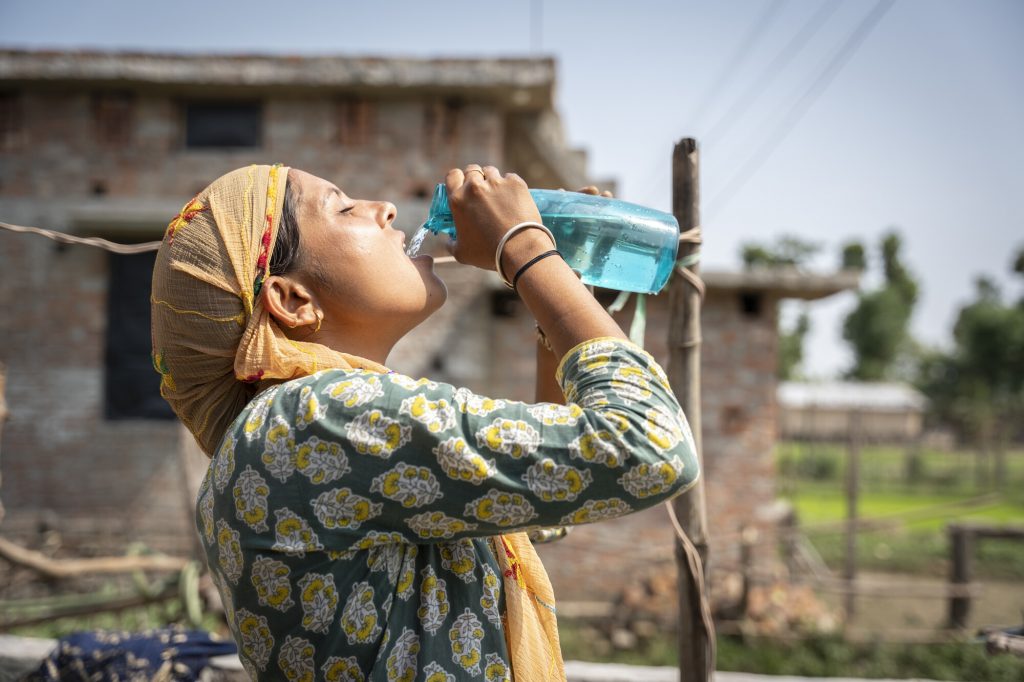The deadly trail of Hurricane Matthew
Written by María José Agejas, journalist in the Communication Department of Oxfam Intermón.
Jean Robert looks around, still unable to believe his eyes. “I never saw anything like it, the speed of it. Truly terrible.”
The primary school where he teaches was blown to smithereens by the hurricane as it swept through. Luckily, thanks to radio announcements – which many people ignored – the children were not at school that day. “If the kids had been inside, there would have been many deaths.”
The school is in the little village of Torbeck, where Hurricane Matthew caused 18 deaths. Hardly any schools or health centres have been left standing in the areas hardest hit by the hurricane where, according to Oxfam’s country director for Haiti, Damien Berrendorf, the damage to infrastructure is comparable to that caused by the 2010 earthquale.
As we continue along the same road, which goes from Les Cayes to Port Salut, Berrendorf’s words are shown to be true. Not a single house is unscathed. Some have lost thier roofs, but many others, even those built of concrete blocks, have been reduced to rubble. All the electricity posts are lying on the ground, submerged in lakes that have formed where crops once stood. In an area where 80% of the population relies on subsistence agriculture, the first immediate consequence is hunger. In this region, hunger is not lurking around the corner: it has been here from day one. With their houses flooded and their crops lost, many people who live from day to day without savings have absolutely nothing to eat or with which to feed their children.
“We have nothing, absolutely nothing,” says Senita Terbil, a 26-year-old mother of two. Her house was built of concrete blocks. Now it looks as if a bulldozer has flattened it. She has lost her home, her vegetable patch and her animals. “We’d like to replant the vegetable garden, but we don’t have the means to do it. We have no seeds or tolos.” Her husband has built them a makeshift shelter out of sheets of corrugated iron. Inside, her sister-in-law is lying in bed. A tree fell on her, leaving her with a broken arm and leg, both of which are wrapped in torn sheets. She has no money to see a doctor.
We carry on towards the eastern tip of the island, the point where Matthew made landfall. We are in the Département du Sud, which together with Grand’Anse, was the administrative region hit hardest by the hurricane. According to the United Nations, 750,000 people in this region need emergency aid. Port Salut was one of Haiti’s prettiest towns: a tourist destination, bordered by blue sea, but its colonial-era hotels were unable to withstand Matthew’s onslaught. The bridge across the river in the town center has disappeared. Everywhere residents are trying, machetes in hand, to chop away trees that have fallen on their houses, and hauling mattresses and clothing outside to dry in the sun, which came out again once the hurricane had passed.
Further inland, in the emergency shelter set up at the town hall in Camp Perrin, children try to forget their hunger by running about and clustering round the foreign visitors, while once again we meet the same incredulous expressions when we go over to talk with the adults.
“Yes, we heard the message on the radio and television. We also received a text message on our mobiles,” explains Germaine Cheri, 52, a widowed mother of ten. “But in Haiti hurricane warnings are sometimes issued for what turns out to be only rain. We thought there would just be rain, but this time the hurricane came when we were sleeping and swept everything away, and then we saw it was another story altogether.”
Germaine Cheri has lost everything. “I have nothing, not even food to give my children. We’ve lost everything that was in the house: our bed, our clothes. All I have is what I am wearing, nothing more.”
Standing nearby, 37-year-old Bernadette Julien echoes Germaine’s story almost word for word: “All I have left are my children and the clothes I’m standing in. The house is completely destroyed. I have nothing to give my children.” Bernadette is eight months pregnant with her eighth child.
Case after case illustrates the tragic reality of this hurricane. Clearly, there will be many more deaths in the short and medium term than those caused by the wind and rain. Not just because of crop losses, but also because there will very probably be another outbreak of cholera, a disease linked to dirty water and poor hygiene that is already claiming lives in the affected areas.
According to the Haitian government, 10,000 people have died of Cholera since 2010, and a total of 800,000 have had the disease. One of Oxfam’s first tasks has been to distribute hygiene kits and install tanks of clean water in some of the areas affected by the hurricane, to prevent an all too likely further outbreak of cholera.
Crop losses, destruction of infrastructure of every type, from schools to bridges, diseases linked to water pollution… and a population already living on the brink, without a safety net, even before Matthew’s passage. Unless an adequate response is planned, the hurricane will leave a long trail of death behind it, warns Oxfam. There is a huge need for hurricane-proof rebuilding strategies, proper urban planning and a thorough study of risk prevention.

